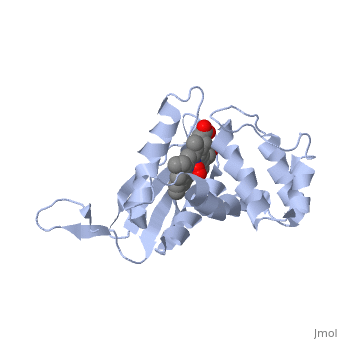1xbn: Difference between revisions
Jump to navigation
Jump to search
New page: left|200px<br /><applet load="1xbn" size="450" color="white" frame="true" align="right" spinBox="true" caption="1xbn, resolution 2.50Å" /> '''Crystal structure of... |
No edit summary |
||
| (16 intermediate revisions by the same user not shown) | |||
| Line 1: | Line 1: | ||
== | ==Crystal structure of a bacterial nitric oxide sensor: an ortholog of mammalian soluble guanylate cyclase heme domain== | ||
<StructureSection load='1xbn' size='340' side='right'caption='[[1xbn]], [[Resolution|resolution]] 2.50Å' scene=''> | |||
== Structural highlights == | |||
<table><tr><td colspan='2'>[[1xbn]] is a 1 chain structure with sequence from [https://en.wikipedia.org/wiki/Caldanaerobacter_subterraneus_subsp._tengcongensis_MB4 Caldanaerobacter subterraneus subsp. tengcongensis MB4]. Full crystallographic information is available from [http://oca.weizmann.ac.il/oca-bin/ocashort?id=1XBN OCA]. For a <b>guided tour on the structure components</b> use [https://proteopedia.org/fgij/fg.htm?mol=1XBN FirstGlance]. <br> | |||
</td></tr><tr id='method'><td class="sblockLbl"><b>[[Empirical_models|Method:]]</b></td><td class="sblockDat" id="methodDat">X-ray diffraction, [[Resolution|Resolution]] 2.5Å</td></tr> | |||
<tr id='ligand'><td class="sblockLbl"><b>[[Ligand|Ligands:]]</b></td><td class="sblockDat" id="ligandDat"><scene name='pdbligand=HEM:PROTOPORPHYRIN+IX+CONTAINING+FE'>HEM</scene>, <scene name='pdbligand=OXY:OXYGEN+MOLECULE'>OXY</scene></td></tr> | |||
<tr id='resources'><td class="sblockLbl"><b>Resources:</b></td><td class="sblockDat"><span class='plainlinks'>[https://proteopedia.org/fgij/fg.htm?mol=1xbn FirstGlance], [http://oca.weizmann.ac.il/oca-bin/ocaids?id=1xbn OCA], [https://pdbe.org/1xbn PDBe], [https://www.rcsb.org/pdb/explore.do?structureId=1xbn RCSB], [https://www.ebi.ac.uk/pdbsum/1xbn PDBsum], [https://prosat.h-its.org/prosat/prosatexe?pdbcode=1xbn ProSAT]</span></td></tr> | |||
</table> | |||
== Function == | |||
[https://www.uniprot.org/uniprot/Q8RBX6_CALS4 Q8RBX6_CALS4] | |||
== Evolutionary Conservation == | |||
[[Image:Consurf_key_small.gif|200px|right]] | |||
Check<jmol> | |||
<jmolCheckbox> | |||
<scriptWhenChecked>; select protein; define ~consurf_to_do selected; consurf_initial_scene = true; script "/wiki/ConSurf/xb/1xbn_consurf.spt"</scriptWhenChecked> | |||
<scriptWhenUnchecked>script /wiki/extensions/Proteopedia/spt/initialview01.spt</scriptWhenUnchecked> | |||
<text>to colour the structure by Evolutionary Conservation</text> | |||
</jmolCheckbox> | |||
</jmol>, as determined by [http://consurfdb.tau.ac.il/ ConSurfDB]. You may read the [[Conservation%2C_Evolutionary|explanation]] of the method and the full data available from [http://bental.tau.ac.il/new_ConSurfDB/main_output.php?pdb_ID=1xbn ConSurf]. | |||
<div style="clear:both"></div> | |||
== | ==See Also== | ||
*[[Chemotaxis protein 3D structures|Chemotaxis protein 3D structures]] | |||
*[[Methyl-accepting chemotaxis protein|Methyl-accepting chemotaxis protein]] | |||
__TOC__ | |||
</StructureSection> | |||
[[Category: | [[Category: Caldanaerobacter subterraneus subsp. tengcongensis MB4]] | ||
[[Category: | [[Category: Large Structures]] | ||
[[Category: Nioche | [[Category: Nioche P]] | ||
[[Category: Raman | [[Category: Raman CS]] | ||
Latest revision as of 11:49, 14 February 2024
Crystal structure of a bacterial nitric oxide sensor: an ortholog of mammalian soluble guanylate cyclase heme domainCrystal structure of a bacterial nitric oxide sensor: an ortholog of mammalian soluble guanylate cyclase heme domain
Structural highlights
FunctionEvolutionary Conservation Check, as determined by ConSurfDB. You may read the explanation of the method and the full data available from ConSurf. See Also |
| ||||||||||||||||||
